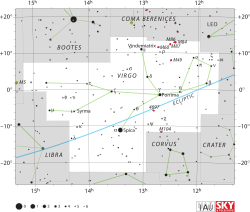69 Virginis
| 69 Virginis | |
 | |
| Observationsdata Epok: J2000.0 | |
|---|---|
| Stjärnbild | Jungfrun |
| Rektascension | 13t 27m 27,16348s[1] |
| Deklination | -15° 58′ 24,8980″[2] |
| Skenbar magnitud () | +4,76[3] 4,75 – 4,79 (V)[4] |
| Stjärntyp | |
| Spektraltyp | K0 III-IIIb CN1.5 CH0.5[5] |
| U–B | +1,06[6] |
| B–V | +1,096 ± 0,004[7] |
| Variabeltyp | Misstänkt variabel[4] |
| Astrometri | |
| Radialhastighet () | -12,9 ± 0,5[8] km/s |
| Egenrörelse (µ) | RA: -121,016 ± 0,394[1] mas/år Dek.: 21,187 ± 0,326[1] mas/år |
| Parallax () | 12,5871 ± 0,2367[1] |
| Avstånd | 259 ± 5 lå (79 ± 1 pc) |
| Absolut magnitud () | 0,09[3] |
| Detaljer | |
| Massa | 3,51 ± 0,94[9] M☉ |
| Radie | 15[10] R☉ |
| Luminositet | 87,1[10] L☉ |
| Temperatur | 4 909 ± 92[9] K |
| Metallicitet | 0,11[11] dex |
| Vinkelhastighet | 4,3[10] km/s |
| Ålder | 288[9] miljoner år |
| Andra beteckningar | |
| 2MASS J13272717-1558245[12], HD 116976[12], HIP 65639[12], HR 5068[12], IRAS 13247-1542[12], SAO 157946[12], GSC 06120-00921[12], GJ 511.2[12], GJ 9444[12], CSV 101385[12], GC 18181[12], GCRV 7980[12], HIC 65639[12], IRC -20253[12], JP11 2394[12], NSV 6253[12], PLX 3070[12], PLX 3070.00[12], PPM 227314[12], TYC 6120-921-1[12], UBV 12118[12], YZ 105 5090[12], WEB 11614[12], Gaia DR2 3604865252393354112[12], 69 Vir, Gaia DR3 3604865252393354112[12], TIC 297143306[12], UBV M 19393[12] och EPIC 212356048[12][13] | |
69 Virginis, som är stjärnans Flamsteed-beteckning, är en ensam stjärna[14] i den södra delen av stjärnbilden Jungfrun,[10]. Den har en genomsnittlig skenbar magnitud på ca 4,76[3] och är svagt synlig för blotta ögat där ljusföroreningar ej förekommer. Baserat på parallaxmätning inom Hipparcosuppdraget på ca 12,6[1] mas, beräknas den befinna sig på ett avstånd på ca 259 ljusår (ca 79 parsek) från solen. Den rör sig närmare solen med en heliocentrisk radialhastighet på ca -13 km/s.[8] Ljuset från stjärnan är polariserat på grund av mellanliggande interstellärt stoft. [15]
Egenskaper
[redigera | redigera wikitext]59 Virginis är en orange till gul jättestjärna av spektralklass K0 III-IIIb CN1.5 CH0.5,[5] som visar överskott av CN- och CH-molekyler i spektrumet. Den ingår i röda klumpen, vilket betyder att den befinner sig på den horisontella jättegrenen och genererar energi genom termonukleär fusion helium i dess kärna.[16] Den har en massa som är ca 3,5[9] solmassor, en radie som är ca 15[10] solradier och utsänder ca 87[10] gånger mera energi än solen från dess fotosfär vid en effektiv temperatur på ca 4 900 K.[9]
69 Virginis är en misstänkt variabel,[4] som varierar mellan visuell magnitud +4,75 och 4,79[17] utan någon fastställd periodicitet.[4]
Se även
[redigera | redigera wikitext]Referenser
[redigera | redigera wikitext]- Den här artikeln är helt eller delvis baserad på material från engelskspråkiga Wikipedia, 69 Virginis, 12 februari 2020.
Noter
[redigera | redigera wikitext]- ^ [a b c d e] Brown, A. G. A.; et al. (Gaia collaboration) (August 2018). "Gaia Data Release 2: Summary of the contents and survey properties". Astronomy & Astrophysics. 616. A1. arXiv:1804.09365. Bibcode:2018A&A...616A...1G. doi:10.1051/0004-6361/201833051. Gaia DR2 record for this source at VizieR.
- ^ ”Basic data: V* 69 Vir – High proper-motion Star” (på engelska). Centre de Données astronomiques de Strasbourg. http://simbad.u-strasbg.fr/simbad/sim-basic?Ident=69+Vir&submit=SIMBAD+search. Läst 16 september 2019.
- ^ [a b c] Anderson, E.; Francis, Ch. (2012), "XHIP: An extended hipparcos compilation", Astronomy Letters, 38 (5): 331, arXiv:1108.4971, Bibcode:2012AstL...38..331A, doi:10.1134/S1063773712050015.
- ^ [a b c d] ”NSV 6253” (på engelska). The International Variable Star Index. AAVSO – American Association of Variable Star Observers. http://www.aavso.org/vsx/index.php?view=detail.top&oid=44877. Läst 16 september 2019.
- ^ [a b] Keenan, Philip C.; McNeil, Raymond C. (1989), "The Perkins catalog of revised MK types for the cooler stars", Astrophysical Journal Supplement Series, 71: 245, Bibcode:1989ApJS...71..245K, doi:10.1086/191373.
- ^ Hoffleit, Dorrit; Jaschek, Carlos (1991), "The Bright star catalogue", New Haven, Bibcode:1991bsc..book.....H
- ^ van Leeuwen (2007). ”Hipparcos, the New Reduction” (på engelska). http://vizier.u-strasbg.fr/viz-bin/VizieR-5?-out.add=.&-source=I/311/hip2&HIP=65639. Läst 16 september 2019.
- ^ [a b] de Bruijne, J. H. J.; Eilers, A.-C. (October 2012), "Radial velocities for the HIPPARCOS-Gaia Hundred-Thousand-Proper-Motion project", Astronomy & Astrophysics, 546: 14, arXiv:1208.3048, Bibcode:2012A&A...546A..61D, doi:10.1051/0004-6361/201219219, A61.
- ^ [a b c d e] Feuillet, Diane K.; et al. (2016), "Determining Ages of APOGEE Giants with Known Distances", The Astrophysical Journal, 817 (1): 40, arXiv:1511.04088, Bibcode:2016ApJ...817...40F, doi:10.3847/0004-637x/817/1/40.
- ^ [a b c d e f] Massarotti, Alessandro; et al. (January 2008), "Rotational and Radial Velocities for a Sample of 761 HIPPARCOS Giants and the Role of Binarity", The Astronomical Journal, 135 (1): 209–231, Bibcode:2008AJ....135..209M, doi:10.1088/0004-6256/135/1/209.
- ^ Meléndez, J.; et al. (June 2008), "Chemical similarities between Galactic bulge and local thick disk red giant stars", Astronomy and Astrophysics, 484 (3): L21–L25, arXiv:0804.4124, Bibcode:2008A&A...484L..21M, doi:10.1051/0004-6361:200809398.
- ^ [a b c d e f g h i j k l m n o p q r s t u v w x y z aa ab] SIMBAD Astronomical Database.[källa från Wikidata]
- ^ "69 Vir". SIMBAD. Centre de données astronomiques de Strasbourg. Hämtad 2019-02-10.
- ^ Eggleton, P. P.; Tokovinin, A. A. (September 2008), "A catalogue of multiplicity among bright stellar systems", Monthly Notices of the Royal Astronomical Society, 389 (2): 869–879, arXiv:0806.2878, Bibcode:2008MNRAS.389..869E, doi:10.1111/j.1365-2966.2008.13596.x.
- ^ Leroy, J. L. (July 1993), "A Polarimetric Investigation on Interstellar Dust Within 50-PARSECS from the Sun", Astronomy and Astrophysics, 274 (1): 203, Bibcode:1993A&A...274..203L.
- ^ Alves, David R. (August 2000), "K-Band Calibration of the Red Clump Luminosity", The Astrophysical Journal, 539 (2): 732–741, arXiv:astro-ph/0003329, Bibcode:2000ApJ...539..732A, doi:10.1086/309278.
- ^ Samus, N. N.; et al. (2017), "General Catalogue of Variable Stars", Astronomy Reports, 5.1, 61 (1): 80–88, Bibcode:2017ARep...61...80S, doi:10.1134/s1063772917010085.





